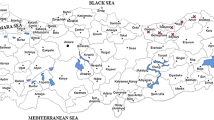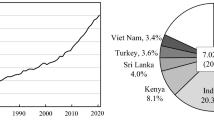Abstract
In some tea tree planting areas within 300 km from the TEPCO’s Fukushima Daiichi Nuclear Power Plant (FNPP), it was found that newly emerged tea plant leaves for green tea contained two radiocesium species (cesium-134 and cesium-137). In this study, using processed green tea leaves for drinking, extraction ratios of radiocesium under several brew conditions were observed. When 90 °C water was used, 50–70% of radiocesium was extracted into the water, while 54–60% of radiocesium was extracted with 60 °C water. A part of radiocesium would be removed from leaves if the leaves were washed with 20 and 60 °C water before brewing, and the efficiencies were 11 and 32%, respectively. Newly emerged camellia leaves were used to simulate the radiocesium removal ratio from raw tea leaves by washing and boiling; radioactivity concentration was decreased to 60% of the original concentration with washing and 10 min boiling. From these results, it was found that almost half of the radiocesium would not be removed from raw or processed tea leaves. The values obtained in the present study could be used for internal radiation dose estimation from tea leaves.
Similar content being viewed by others
References
Changlai SP, Tsai HH, Tsai SC, Chen HP, Chang CL, Yao YH, Chen CY (2011) J Radioanal Nucl Chem. doi:10.1007/s10967-011-1376-4
Ministry of Health, Labour and Welfare, Japan (2011) http://www.mhlw.go.jp/stf/houdou/2r9852000001558e.html. Accessed 15 Aug 2011
Ministry of Education, Culture, Sports, Science and Technology, Japan (2011) http://radioactivity.mext.go.jp/ja/monitoring_by_prefecture_fallout/. Accessed 12 Aug 2011
International Atomic Energy Agency (2009) Quantification of radionuclide transfer in terrestrial and freshwater environments for radiological assessments. IAEA-TECDOC-1616, IAEA, Vienna
Radioactive Waste Management Center (1994) Removal of radionuclides during food processing and culinary preparation. Environmental parameters series 4. RWMC-94-P-16. Radioactive Waste Management Center, Tokyo (In Japanese)
Ministry of Education, Culture, Sports, Science and Technology, Japan (2005) Standard tables of food composition in Japan, 5th revised and enlarged edition, Tokyo. (in Japanese)
Hasegawa H, Tsukada H, Kawabata H, Chikuchi Y, Takaku Y, Hisamatsu S (2009) J Environ Radioact 100:54
Ronneau C, Sombre L, Myttenaere C, Andre P, Vanhouche M, Cara J (1991) J Environ Radioact 14:259
Scotti IA, Silva S (1992) J Environ Radioact 16:97
Topcuoglu S, Güngör N, Köse A, Varinlioglu A (1997) J Radioanal Nucl Chem 218:263
Ministry of Agriculture, Forestry and Fisheries, Japan (2011) http://www.maff.go.jp/j/tokei/sokuhou/syukaku_tya_09/. Accessed 15 Aug 2011
Shiraishi K, Ban-nai T, Muramatsu Y, Yamamoto M (1999) J Radioanal Nucl Chem 242:687
International Commission on Radiological Protection (1996) Age-dependent dose to members of the public from intake of radionuclides: part 5. Compilation of ingestion and inhalation dose coefficients. ICRP Publication 72, Elsevier Science, Oxford
International Atomic Energy Agency (2000) Generic procedures for assessment and response during radiological emergency. IAEA-TECDOC-1162, IAEA, Vienna
Acknowledgments
The authors thank Dr. E. R. Landa (U.S. Geological Survey) for his valuable comments. This study has been partially supported by the Agency for Natural Resources and Energy, the Ministry of Economy, Trade and Industry (METI), Japan.
Author information
Authors and Affiliations
Corresponding author
Rights and permissions
About this article
Cite this article
Tagami, K., Uchida, S. & Ishii, N. Extractability of radiocesium from processed green tea leaves with hot water: the first emergent tea leaves harvested after the TEPCO’s Fukushima Daiichi Nuclear Power Plant accident. J Radioanal Nucl Chem 292, 243–247 (2012). https://doi.org/10.1007/s10967-011-1398-y
Received:
Published:
Issue Date:
DOI: https://doi.org/10.1007/s10967-011-1398-y




